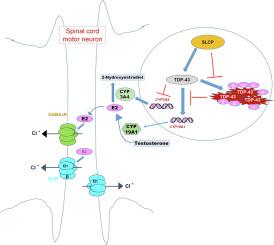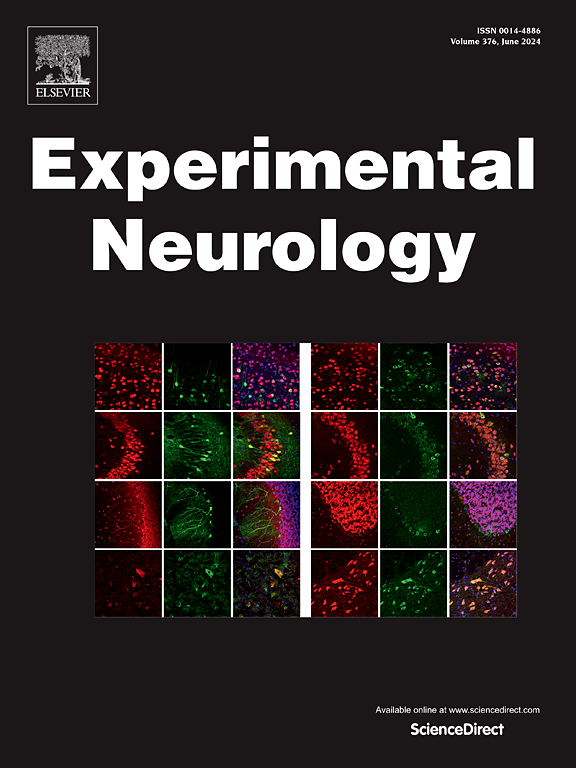Potential role of solid lipid curcumin particle (SLCP) as estrogen replacement therapy in mitigating TDP-43-related neuropathy in the mouse model of ALS disease
IF 4.6
2区 医学
Q1 NEUROSCIENCES
引用次数: 0
Abstract
Background
Amyotrophic lateral sclerosis (ALS) was first identified in 1869, but it wasn't until the 2014 Ice Bucket Challenge that widespread attention was drawn to the disease. Since then, substantial research has been dedicated to developing treatments for ALS. Despite this, only three drugs - riluzole, edaravone and AMX0035, have been approved for clinical use, and they can only temporarily alleviate mild symptoms without significant disease modification or cure. Therefore, there remains a critical unmet need to identify disease modifying or curative therapies for ALS. The higher incidence and more severe progression of ALS and FTLD (frontotemporal lobar degeneration) observed in men and postmenopausal woman compared to young women suggests that sex hormones may significantly influence disease onset and progression. In both animal models and human clinical studies, 17β estradiol (E2) has been shown to delay and improve the outcomes of many neurodegenerative diseases. Here, we examined the role of TDP-43 in the regulation of estrogen-related enzymes, CYP19A1 and CYP3A4. In addition, we examined the impact of curcumin on the regulation of estrogen E2 levels and TDP-43-associated neuropathy as a potential therapeutic strategy for the treatment of FTLD and ALS.
Methods
Prp-TDP-43A315T mice was used as a model of ALS/FTLD to examine the expression patterns of E2 and its biosynthesis and degradation enzymes, CYP19A1 and CYP3A4. Moreover, the molecular mechanisms and the potency of solid lipid curcumin particles (SLCP) as an E2 replacement therapy for TDP-43 associated neuropathy was analyzed. We further examined the survival rates and the pathological TDP43 patterns in female and male Prp-TDP-43A315T mice administrated with or without SLCP. In addition, the changed expression levels of enzymes corresponding to E2 biosynthesis and degradation in the spinal cord of female and male Prp-TDP-43A315T mice with or without SLCP were determined.
Results
We found that in addition to E2, the expression patterns of CYP19A1 and CYP3A4 proteins differed between Prp-TDP-43A315T mice compared to wild-type control, suggesting that toxic phosphorylated TDP43 oligomers may disrupt the balance between CYP19A1 and CYP3A4 expression, leading to reduced estrogen biosynthesis and accelerated degradation. In addition, we found that oral administration of SLCP prolonged the survival rates in female Prp-TDP-43A315T mice and significantly reduced the pathological insoluble phosphorylated TDP-43 species. Furthermore, SLCP attenuated disease progression associated with TDP-43-related neuropathies through modulating estrogen biosynthesis and the activity of CYP450 enzymes.
Conclusions
Our results showed that Prp-TDP-43A315T mice exhibit altered estradiol levels. Moreover, we demonstrated the efficacy of SLCP as an estrogen replacement therapy in mitigating TDP-43-associated disease progression and pathogenesis. These findings suggest that SLCP could be a promising strategy to induce E2 expression for the treatment of ALS and FTLD.

固体脂质姜黄素颗粒(SLCP)作为雌激素替代疗法在缓解 ALS 小鼠模型中与 TDP-43 相关的神经病变中的潜在作用。
背景:肌萎缩性脊髓侧索硬化症(ALS)于 1869 年首次被发现,但直到 2014 年的 "冰桶挑战 "才引起了人们对该疾病的广泛关注。从那时起,大量研究致力于开发 ALS 的治疗方法。尽管如此,目前只有利鲁唑、依达拉奉和AMX0035三种药物被批准用于临床,而且它们只能暂时缓解轻微症状,无法显著改变或治愈疾病。因此,确定 ALS 的疾病改变或治愈疗法仍是一项尚未满足的重大需求。与年轻女性相比,男性和绝经后女性的 ALS 和 FTLD(额颞叶变性)发病率更高,病情发展更严重,这表明性激素可能对疾病的发生和发展有重大影响。在动物模型和人类临床研究中,17β雌二醇(E2)已被证明能延缓和改善许多神经退行性疾病的预后。在这里,我们研究了 TDP-43 在调节雌激素相关酶 CYP19A1 和 CYP3A4 中的作用。此外,我们还研究了姜黄素对调节雌激素 E2 水平和 TDP-43 相关神经病变的影响,并将其作为治疗 FTLD 和 ALS 的潜在治疗策略:方法:以Prp-TDP-43A315T小鼠为ALS/FTLD模型,研究E2及其生物合成和降解酶CYP19A1和CYP3A4的表达模式。此外,我们还分析了固体脂质姜黄素颗粒(SLCP)作为 E2 替代疗法治疗 TDP-43 相关神经病变的分子机制和有效性。我们进一步研究了使用或不使用SLCP的雌性和雄性Prp-TDP-43A315T小鼠的存活率和病理TDP43模式。此外,我们还测定了服用或未服用SLCP的雌性和雄性Prp-TDP-43A315T小鼠脊髓中对应于E2生物合成和降解的酶的表达水平变化:结果:我们发现,与野生型对照组相比,Prp-TDP-43A315T小鼠除E2外,CYP19A1和CYP3A4蛋白的表达模式也有所不同,这表明毒性磷酸化TDP43寡聚体可能会破坏CYP19A1和CYP3A4表达之间的平衡,导致雌激素生物合成减少和降解加速。此外,我们还发现,口服 SLCP 可延长雌性 Prp-TDP-43A315T 小鼠的存活率,并显著减少病理不溶性磷酸化 TDP-43 物种。此外,SLCP通过调节雌激素的生物合成和CYP450酶的活性,减轻了与TDP-43相关的神经病变相关的疾病进展:我们的研究结果表明,Prp-TDP-43A315T小鼠的雌二醇水平发生了改变。此外,我们还证明了 SLCP 作为一种雌激素替代疗法在缓解 TDP-43 相关疾病进展和发病机制方面的功效。这些研究结果表明,SLCP 可能是诱导 E2 表达以治疗 ALS 和 FTLD 的一种有前途的策略。
本文章由计算机程序翻译,如有差异,请以英文原文为准。
求助全文
约1分钟内获得全文
求助全文
来源期刊

Experimental Neurology
医学-神经科学
CiteScore
10.10
自引率
3.80%
发文量
258
审稿时长
42 days
期刊介绍:
Experimental Neurology, a Journal of Neuroscience Research, publishes original research in neuroscience with a particular emphasis on novel findings in neural development, regeneration, plasticity and transplantation. The journal has focused on research concerning basic mechanisms underlying neurological disorders.
 求助内容:
求助内容: 应助结果提醒方式:
应助结果提醒方式:


